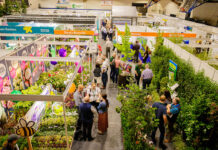![]()
![]()
The International HortiWeek opened with a congress to which an international group of speakers had been invited. They addressed problem-solving approaches that horticulture can offer for the challenges involving water and food supplies in the coming decades. Growing in substrates under protected conditions is one of the spearheads in this process. The speakers emphasized that socio-economic and political factors are important parameters in the introduction of new horticultural techniques.
![]()
![]()
The International HortiWeek opened with a congress to which an international group of speakers had been invited. They addressed problem-solving approaches that horticulture can offer for the challenges involving water and food supplies in the coming decades. Growing in substrates under protected conditions is one of the spearheads in this process. The speakers emphasized that socio-economic and political factors are important parameters in the introduction of new horticultural techniques.
The 7th billion citizen of the world will be born this week and there will be 9 billion people on earth in 2050. All these people must have healthy food. But that is not the only challenge facing the world in the coming decades. The skewed distribution of rich and poor, hunger and obesity and climate changes demand new solutions for water and food supplies.
Golden triangle
“The ability to feed 9 billion people requires cooperation between the business community, knowledge institutions and government. This so-called Golden Triangle is the strength of Dutch horticulture,” said Professor Martin Kropff of Wageningen University and Research centre. “Dutch horticulture is high tech and has proved that it is fully capable of finding innovative solutions for the major challenges.” He referred in this context to examples like the improvement in the taste of tomatoes, new packing technologies, mobile cultivation systems and energy-producing greenhouses. He made the following proviso, however. “We are increasingly realizing that it is not only technology that is crucial, but socio-economic factors as well, particularly in regions where water is scarce. In Ethiopia, for example, horticulture is developing at a tremendous pace. The horticultural areas use water from the lakes and those lakes become empty far too quickly. Effective agreements must be reached quickly to deal with this problem, but that is extremely difficult because different governmental authorities are involved.”
Closed greenhouses
Gene Giacomelli from the University of Arizona also considered the water problem. He concluded that water will be a real problem for 1.8 billion people in 2025: “We have to start work now on solutions that will enable us to produce sufficient food with little water.” The researcher is working on a number of projects involving cultivation under extreme conditions, such as at the South Pole or on Mars. It really is possible to grow vegetables and fruit in a completely conditioned environment. Giacomelli explained that water efficiency of almost one hundred per cent can be achieved in closed greenhouses where the crops grow in substrates and referred to Village Farms in Texas and Houweling Nurseries, where high levels of tomato production are achieved in semi-closed greenhouses with very little water.
No GMOs
Kees Reinink from Rijk Zwaan approached the food problem from a completely different angle: “New techniques enable completely different methods of plant breeding. In the past, selection only used to be possible on the basis of external characteristics. But the method of sequencing now makes it possible for plant breeders to identify hereditary characteristics at gene level. This enables targeted searches for resistance in wild plants for example, or in plants of the same variety, such as cucumbers and melons. This means a tremendous expansion of the prospects for plant breeding. As a consequence, we see no need to work with genetically modified organisms to increase production. In the first place it is expensive, and in the second place public opinion on the subject is much too negative. It is extremely important for the breeding of horticultural crops, incidentally, that Plant Breeders’ Rights remain intact. ”
More than technique
The conclusion that solving the food issue in drylands requires more than technique was also echoed by Richard Tutwiler from the Desert Development Centre in Cairo. A lot of hard work is going on in North Africa in order to decrease the dependency on rain. Horticulture offers options to do this by improving cultivation systems. Tutwiler is convinced that the improvement of existing cultivation techniques will also improve the quality of life for people in the region. “Food security rises, unemployment falls and environmental pollution decreases,” he argued. Tutwiler emphasized that horticulture means more than greenhouses alone for North Africa. “We also see great prospects for vineyards and woody crops in our region.”
To end the congress, Peter Westerveld and Ole Shirim Sayialel of the Naga Foundation presented a clear and simple solution to make the desert green again. By digging ditches of one metre deep, rainwater also actually penetrates into the soil and the natural processes of the soil are revived.
Congress chair Agnes van Ardenne finished with the conclusion that horticulture can contribute many solutions in the technical sense, but that huge challenges remain with regard to making technique accessible for practical implementation, the investments, the necessary management skills and the marketing.
After the close of the congress Liesbeth Spies and Jaap Bond, members of the Provincial Executives for Zuid-Holland and Noord-Holland respectively opened the International HortiWeek together with Dick van Raamsdonk from IFTF, Floris Olthof from Flora Holland and Ewald van Vliet from the Horti Fair.







